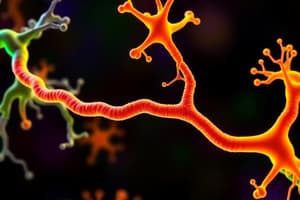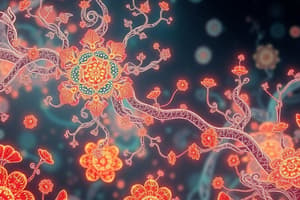Podcast
Questions and Answers
What is the role of phosphorylated tyrosine residues in Receptor Tyrosine Kinases (RTKs)?
What is the role of phosphorylated tyrosine residues in Receptor Tyrosine Kinases (RTKs)?
- They catalyze the degradation of the receptor.
- They act as docking sites for adapter proteins. (correct)
- They serve as binding sites for signaling molecules.
- They inhibit kinase activity.
Which protein is mentioned as an example that binds through the SH2 domain to activated RTKs?
Which protein is mentioned as an example that binds through the SH2 domain to activated RTKs?
- Grb2 (correct)
- PI3 kinase
- IRS1
- Src
What initiates the activation of intracellular signaling in Receptor Tyrosine Kinases?
What initiates the activation of intracellular signaling in Receptor Tyrosine Kinases?
- Cross phosphorylation of tyrosine residues (correct)
- Binding of ligands to the receptor
- Dissociation of adapter proteins
- Phosphorylation of target proteins
How does the insulin receptor contribute to cellular signaling?
How does the insulin receptor contribute to cellular signaling?
Which of the following proteins is specifically activated by binding to an activated PDGF receptor?
Which of the following proteins is specifically activated by binding to an activated PDGF receptor?
What happens to Ras when GTP is bound to it?
What happens to Ras when GTP is bound to it?
Which kinase is directly activated by Ras?
Which kinase is directly activated by Ras?
What is the primary role of MEK in the kinase cascade?
What is the primary role of MEK in the kinase cascade?
What effect does the phosphorylation of transcription factors like fos and jun have?
What effect does the phosphorylation of transcription factors like fos and jun have?
What is the significance of the kinase cascade initiated by Ras?
What is the significance of the kinase cascade initiated by Ras?
What role does AKT play in cellular metabolism?
What role does AKT play in cellular metabolism?
Which component directly activates Ras in the signaling pathway?
Which component directly activates Ras in the signaling pathway?
What is the primary function of the GAP protein in the Ras signaling pathway?
What is the primary function of the GAP protein in the Ras signaling pathway?
Which of the following statements about receptor tyrosine kinases (RTKs) is correct?
Which of the following statements about receptor tyrosine kinases (RTKs) is correct?
What is a major consequence of persistent activation of Ras due to dominant mutations?
What is a major consequence of persistent activation of Ras due to dominant mutations?
Which statement accurately describes the PI3 kinase signaling pathway?
Which statement accurately describes the PI3 kinase signaling pathway?
What is the outcome of MAP kinases phosphorylating transcription factors?
What is the outcome of MAP kinases phosphorylating transcription factors?
How are protein kinase cascades advantageous in signal transduction?
How are protein kinase cascades advantageous in signal transduction?
What is the initial event that occurs upon ligand binding to a Receptor Tyrosine Kinase (RTK)?
What is the initial event that occurs upon ligand binding to a Receptor Tyrosine Kinase (RTK)?
What is true about the structure of most Receptor Tyrosine Kinases?
What is true about the structure of most Receptor Tyrosine Kinases?
Which of the following ligands can cross bind to Receptor Tyrosine Kinases?
Which of the following ligands can cross bind to Receptor Tyrosine Kinases?
What is the role of heterodimerization in the activation of Receptor Tyrosine Kinases?
What is the role of heterodimerization in the activation of Receptor Tyrosine Kinases?
Which statement is true concerning ligand shedding in RTK signaling?
Which statement is true concerning ligand shedding in RTK signaling?
What consequence does receptor dimerization have on RTKs?
What consequence does receptor dimerization have on RTKs?
What defines the unique function of Receptor Tyrosine Kinases compared to other receptor types?
What defines the unique function of Receptor Tyrosine Kinases compared to other receptor types?
What is commonly found in the structure of Receptor Tyrosine Kinases?
What is commonly found in the structure of Receptor Tyrosine Kinases?
Which biological processes are commonly associated with Receptor Tyrosine Kinases?
Which biological processes are commonly associated with Receptor Tyrosine Kinases?
What type of signaling process is initiated following ligand-receptor interaction in RTKs?
What type of signaling process is initiated following ligand-receptor interaction in RTKs?
What initiates the activation of Ras in the signaling pathway?
What initiates the activation of Ras in the signaling pathway?
Which domain of the GRB2 protein allows it to bind to receptor phosphotyrosine residues?
Which domain of the GRB2 protein allows it to bind to receptor phosphotyrosine residues?
What role does the protein Sos play in the activation of Ras?
What role does the protein Sos play in the activation of Ras?
How does the activated Ras-GTP complex affect downstream signaling?
How does the activated Ras-GTP complex affect downstream signaling?
What happens to the Ras protein after it is activated by Sos?
What happens to the Ras protein after it is activated by Sos?
Which of the following correctly describes the process of receptor activation by EGF?
Which of the following correctly describes the process of receptor activation by EGF?
What is a primary function of Ras in signaling pathways?
What is a primary function of Ras in signaling pathways?
How does the activation of receptor tyrosine kinases influence the SH2 domain protein interactions?
How does the activation of receptor tyrosine kinases influence the SH2 domain protein interactions?
Flashcards
RTK Activation
RTK Activation
Receptor Tyrosine Kinases (RTKs) are activated when a ligand binds to the receptor, causing a conformational change. This change leads to the receptor's autophosphorylation, initiating a signaling cascade.
Cross-Phosphorylation
Cross-Phosphorylation
When two RTKs bind to a ligand, they bring their kinase domains close together. These domains then phosphorylate each other on specific tyrosine residues, fully activating their kinase activity.
Docking Sites & Adapter Proteins
Docking Sites & Adapter Proteins
Phosphorylated tyrosine residues on activated RTKs act as docking sites for adapter proteins, which can bind via their SH2 domains. These adapter proteins then recruit other signaling molecules, triggering downstream signaling events.
PI3 Kinase
PI3 Kinase
Signup and view all the flashcards
Regulation of RTKs
Regulation of RTKs
Signup and view all the flashcards
RTKs
RTKs
Signup and view all the flashcards
Ligand Binding
Ligand Binding
Signup and view all the flashcards
Receptor Activation
Receptor Activation
Signup and view all the flashcards
Autophosphorylation
Autophosphorylation
Signup and view all the flashcards
Signal Transmission
Signal Transmission
Signup and view all the flashcards
RTK Dimerization
RTK Dimerization
Signup and view all the flashcards
Tyrosine Kinase Activity
Tyrosine Kinase Activity
Signup and view all the flashcards
Docking Sites
Docking Sites
Signup and view all the flashcards
Signal Transduction Pathway
Signal Transduction Pathway
Signup and view all the flashcards
Diverse Functions of RTKs
Diverse Functions of RTKs
Signup and view all the flashcards
Raf-1 Kinase
Raf-1 Kinase
Signup and view all the flashcards
Kinase Cascade
Kinase Cascade
Signup and view all the flashcards
Ras Tethering
Ras Tethering
Signup and view all the flashcards
SOS Role
SOS Role
Signup and view all the flashcards
GRB2 Binding
GRB2 Binding
Signup and view all the flashcards
EGF Receptor Dimerization
EGF Receptor Dimerization
Signup and view all the flashcards
Tyrosine Kinase Receptor Phosphorylation
Tyrosine Kinase Receptor Phosphorylation
Signup and view all the flashcards
SH2 Domain Binding
SH2 Domain Binding
Signup and view all the flashcards
Ras-GTP Complex Activation
Ras-GTP Complex Activation
Signup and view all the flashcards
MAP kinase pathway
MAP kinase pathway
Signup and view all the flashcards
Oncogenes
Oncogenes
Signup and view all the flashcards
Dominant Ras Mutations
Dominant Ras Mutations
Signup and view all the flashcards
Study Notes
Receptor Tyrosine Kinases (RTKs)
- RTKs are cell surface receptors directly linked to intracellular enzymes (kinases)
- Many growth factor receptors are part of this family, including PDGF, NGF, EGF, FGF, VEGF, insulin, and IGF1
- Receptors can be single polypeptides or dimers (two single peptides that dimerize upon ligand activation)
Learning Outcomes
- This lecture introduces the tyrosine kinase-linked receptors (RTKs)
- Includes ligand binding and receptor activation
- Describes signal initiation and transmission (players)
- Explains diverse functions of RTKs
- Investigates implications in biological processes
Overview of RTKs: Family Members
- Insulin and IGF1 can cross-bind
- Includes receptors like EGF, insulin, IGF-1, NGF, FGF, PDGF, M-CSF, VEGF, Eph receptor
- Each type has its own unique domains (e.g., cysteine-rich, tyrosine kinase, immunoglobulin-like)
Overview of RTKs: Structure
- RTKs have an extracellular ligand-binding domain
- A single-pass transmembrane α-helix
- A cytosolic C-terminal domain with intrinsic tyrosine kinase activity
- Ligand binding triggers autophosphorylation of the receptor
Mechanism of Activation: Receptor-Ligand Binding
- Ligands form dimers through disulfide bonds
- Ligands bind to two identical receptor binding sites
- Binding of the hormone causes receptor dimerization
- Initiates intracellular signaling
Mechanism of Activation: Receptor Dimerization and Kinase Activation
- Receptor dimerization leads to autophosphorylation
- Each receptor cross-phosphorylates a specific tyrosine residue on its counterpart
- Activation of its kinase activity
Mechanism of Activation: Docking of signaling molecules at RTK
- Phosphorylated tyrosine residues on RTKs become docking sites for adapter proteins
- These adapter proteins can be proteins like Grb2, which have SH2 domains
Mechanism of Activation: The Binding of SH2-containing signaling proteins
- Phosphorylated tyrosines can be specifically identified by SH2 domains on other proteins, including adapter proteins
- Activated receptors can phosphorylate these bound proteins
- This leads to intracellular signal transmission
Initiation of Cellular Response
- 2 insulin molecules bind and induce a conformational change in the receptor
- Autophosphorylates and catalyzes phosphorylation of target proteins like IRS1
- Initiates multiple cellular responses (e.g., insulin signaling activates glucose transport)
Transduction of Response
- Protein kinase cascades amplify signals at each step
- Information received at the plasma membrane is communicated to the nucleus
- Multiple steps in the pathway provide specificity
- Various target proteins provide diversity in response
RTK Signaling: Ras Pathway
- Ras is a monomeric GTPase switch protein
- Activation is enhanced by GEF (guanine nucleotide exchange factor)
- GDP-GTP exchange leads to activation
- Deactivation requires GAP (GTPase-activating proteins) that increase intrinsic GTPase activity
- Once active, Ras propagates signaling through a MAP kinase cascade
- Mutant RTKs or Ras/MAP kinase signaling proteins are linked with nearly all cancers
Ras activation mechanism
- EGF binding causes receptor dimerization and autophosphorylation
- GRB2 binds to phosphorylated tyrosines; GRB2 contains SH3 domains that allow SOS protein to bind to the membrane complex
- SOS then recruits Ras to the complex
- SOS promotes GTP exchange for GDP on Ras
- Active Ras-GTP complex dissociates from Sos
- Active Ras then activates the MAP kinase portion of the signaling pathway
Mechanism of Tyrosine Kinase Receptors
- Hormone binding causes receptor dimerization/aggregation
- Receptor tyrosine kinase domains phosphorylate C-terminal tyrosines
- Phosphorylation produces binding sites for proteins with SH2 domains (e.g., GRB2 with bound SOS)
- SOS is a GEF that activates Ras by exchanging GDP for GTP
- Activated Ras activates Raf-1 kinase, MEK, and MAPK kinase, resulting in a kinase cascade
- Kinase cascade triggers changes in gene expression which regulate protein activity
Studying That Suits You
Use AI to generate personalized quizzes and flashcards to suit your learning preferences.




